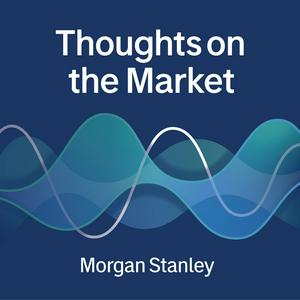Breaking Down the Fed’s New Course
In the first of a two- part episode, our Chief U.S. Economist Michael Gapen and Global Head of Macro Strategy Matthew Hornbach discuss the outcome of the Jackson Hole meeting and the outlook for the U.S. economy and the Fed rate path during the rest of the year. Read more insights from Morgan Stanley.----- Transcript -----Matthew Hornbach: Welcome to Thoughts on the Market. I'm Matthew Hornbach, Global Head of Macro Strategy.Michael Gapen: And I'm Michael Gapen, Morgan Stanley's Chief U.S. Economist.Matthew Hornbach: Last Friday, the Jackson Hole meeting delivered a big surprise to markets. Both stocks and bonds reacted decisively.Today, the first of a two-part episode. We'll discuss Michael's reaction to Chair Powell's Jackson Hole comments and what they mean for his view on the outlook for monetary policy. Tomorrow, the outlook for interest rate markets and the US dollar. It's Thursday, August 28th at 10am in New York. So, Mike, here we are after Jackson Hole. The mood this year felt a lot more hawkish, or at least patient than what we saw last week. And Chair Powell really caught my attention when he said, “with policy and restrictive territory, the baseline outlook for the shifting balance of risks may warrant adjusting our policy stance.” That line has been on my mind ever since. So, let's dig into it. What's your gut reaction?Michael Gapen: Yeah, Matt, it was a surprise to me, and I think I would highlight three aspects of his Jackson Hole comments that were important to me. So, I think what happened here, of course, is the Fed became much more worried about downside risk to the labor market after the July employment report, right? So, at the July FOMC meeting, which came before that report, Powell had said, ‘Well, you know, slow payroll growth is fine as long as the unemployment rate stays low.’ And that's very much in line with our view. But sometimes these things are easier said than done. And I think the July employment report told them perhaps there's more weakness in the labor market now than they thought.So, I think the messaging here is about a shift towards risk management mode. Maybe we need to put in a couple policy rate cuts to shore up the labor market. And I think that was the big change and I think that's what drove the overall message in the statement. But there were two other parts of it that I think were interesting, you know. From the economist’s point of view, when the chair explicitly writes in a speech that ‘the economy now may warrant adjustments in our policy stance,’ right? I mean, that's a big deal. It suggests that the decision has been largely made, and I think anytime the Fed is taking a change of direction, either easing or tightening, they're not just going to do one move. So, they're signaling that they're likely prepared to do a series of moves, and we can debate about what that means. And the third thing that struck me is right before the line that you mentioned he did qualify the need to adjust rates by saying, well, whatever we do, we should, “Proceed cautiously.” So, a year ago, as you recall, the Fed opened up with a big 50 basis point rate cut, which was a surprise. And cut at three successive meetings. So, a hundred basis points of cuts over three meetings, starting with a 50 basis point cut. I think the phraseology ‘proceeds carefully’ is a signal to markets that, ‘Hey, don't expect that this time around.’ The world's different. This is a risk management discussion. And so, we think, two rate cuts before year end would be most likely. Maybe you get three. But I don't think we should expect a large 50 basis point cut at the September meeting. So those would be my thoughts. Downside risk to the labor market – putting this into words says something important to me. And the ‘proceed cautiously’ language I think is something markets also need to take into account.Matthew Hornbach: So how do you translate that into a forecasted path for the Fed? I mean, in terms of your baseline outlook, how many rate cuts are you forecasting this year? And what about in 2026?Michael Gapen: Right. So, we previously; we thought what the Fed was doing was leaning against risks that inflation would be persistent. They moved into that camp because of how fast tariffs were going up and the overall level of the effective tariff rate. So, we thought they would stay on hold for longer and when they move, move more rapidly. What they're saying now in a risk management sense, right; they still think risk to inflation is to the upside, but the unemployment rate is also to the upside. And they're looking at both of those as about equally weighted. So, in a baseline outlook where the Fed's not assuming a recession and neither are we, you get a maybe a dip in growth and a rise in inflation. But growth recovers and inflation comes down next year. In that world, and with the idea that you're proceeding cautiously, they're kind of moving and evaluating, moving and evaluating.So, I think the translation here is: a path of quarterly rate cuts between now and the end of 2026. So, six rate cuts, but moving quarterly, like September and December this year; March, June, September, and December next year; which would take us to a terminal target range of 2.75 to 3. So rather than moving later and more rapidly, you move earlier, but more gradually. That's how we're thinking about it now.Matthew Hornbach: And that's about a 25 basis point upward adjustment to the trough policy rate that you were forecasting previously…Michael Gapen: That's right. So, the prior thought was a Fed that moves later may have to cut more, right? Because you're – by holding policy tighter for longer – you're putting more downward weight on the economy from a cyclical perspective. So, you may end up cutting more to essentially reverse that in 2026. So, by moving earlier, maybe a Fed that moves a little earlier, cuts a little less.Matthew Hornbach: In terms of the alternative outcomes. Obviously, in any given forecast, things can go not as expected. And so, if the path turns out to be something other than what you're forecasting today, what would be some of the more likely outcomes in your mind?Michael Gapen: Yeah, as we like to say in economics, we forecast so we know where we're wrong. So, you're right, the world can evolve very differently. So just a couple thoughts. You know, one, now that we're thinking the Fed does cut in September, what gets them not to cut? You'd need a – I think, a really strong August employment report; something around 225,000 jobs, which would bring the three-month moving average back to around 150, right. That would be a signal that the May-June downdraft was just a post Liberation Day pothole and not trend deterioration in the labor market. So that, you know, would be one potential alternative. Another is – although we've projected quarterly paths in this kind of nice gradual pace of cuts, we could get a repeat of last year where the Fed cuts 50 to 75 basis points by year end but realizes the labor market has not rolled over. And then we get some tariff pass through into inflation. And maybe residual seasonality and inflation in Q1. And then the Fed goes on hold again, then cuts could resume later in the year. And I also think in the backdrop here, when the Fed is saying we are easing in a risk management sense and we're easing maybe earlier than we otherwise would – that suggests the Fed has greater tolerance for inflation. So, understanding how much tolerance this Fed or the next one has for above target inflation, I think could influence how many rate cuts you eventually get in in 2026. So, we could even see a deeper trough through greater inflation tolerance. And finally, of course, we're not out of the woods with respect to recession risk. We could be wrong. Maybe the labor market is trend weakening and we're about to find that out. Growth is slowing. Growth was about 1.3 percent in the first half of the year. Final sales is softer. Of course, in a recession alternative scenario, the Fed's probably cutting much deeper, maybe down to 1 50 to 175 on the funds rate.So, I mean, Matt, you make a good point. There's still many different ways the economy can evolve and many different ways that the Fed's path for policy rates can evolve.Matthew Hornbach: Well, that's a good place to bring this Part 1 episode to an end. Tune in tomorrow, for my reaction to the market price action that followed Chair Powell's speech -- and what it means for our outlook for interest rate markets and the U.S. dollar.Mike, thanks for taking the time to talk.Michael Gapen: Great speaking with you, Matt. Matthew Hornbach: And thanks for listening. If you enjoy Thoughts on the Market, please leave us a review wherever you listen and share the podcast with a friend or colleague today.


